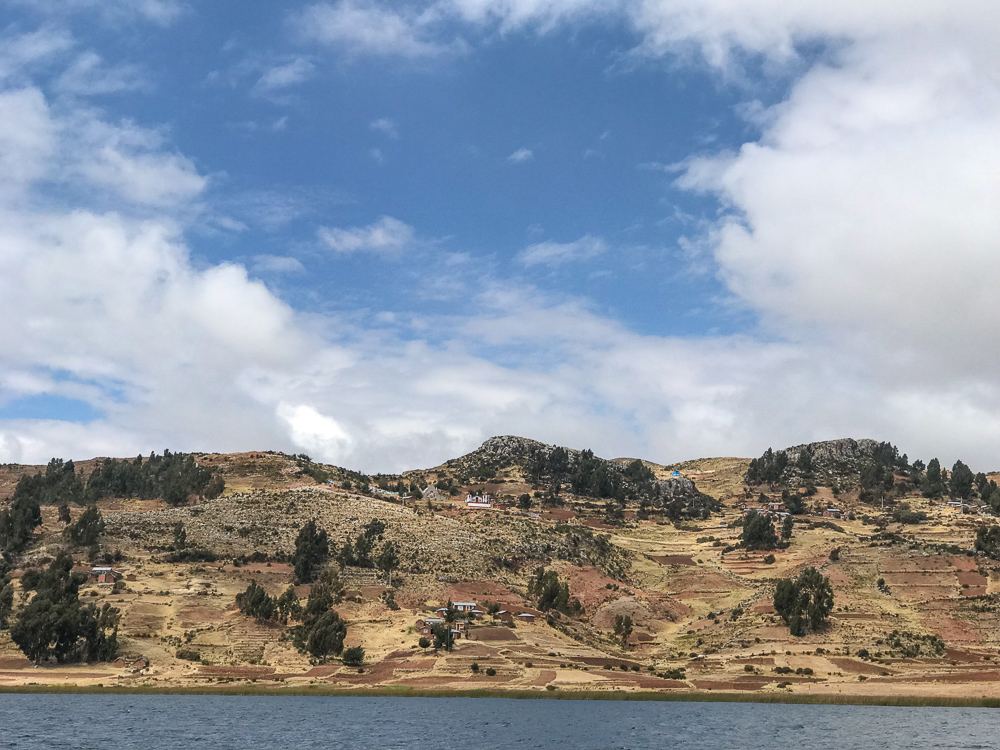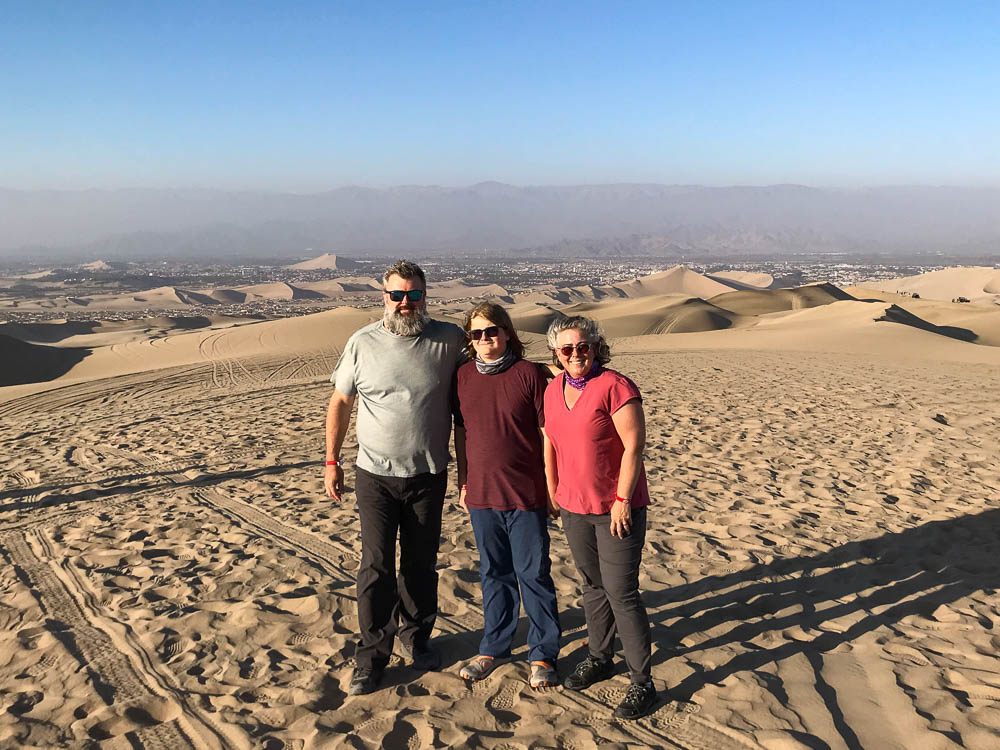RTW – Cusco
We used Cusco as a base to see the surrounding area, Machu Picchu, Ollantaytambo and the Peruvian Amazon. We also had some logistical tasks to complete in the aftermath of our unfortunate incident in Lima, e.g. buying some replacement gear and picking up my new U.S. passport. After all this activity, we eventually had a couple of days to actually do some sightseeing in Cusco.
Cusco Sightseeing – Day 1
Our first day of sightseeing started in the Plaza de Armas. We had actually visited or crossed the Plaza multiple times on our previous days in Cusco, either on the way to somewhere we were going or to eat at one of the restaurants on the square. As we were in sightseeing mode on this day, we spent a bit more time here checking out the sights, including the statue of Pachacuti, an Inca ruler.

The Plaza was busy with tourists and locals.

We saw some processions associated with a local religious festival. We never figured out exactly what it was all about, but it was very colorful and loud.

Moving on from the Plaza, our next stop was the Machu Picchu Museum. It probably would have been helpful to see this place before we went to Machu Picchu itself, but it was interesting nonetheless. The museum displays interesting artifacts from the site. It describes Machu Picchu as a retreat for the Inca ruling class. Our guide at Machu Picchu had given us a different explanation, describing it as a university for the youth of the Inca ruling class. Our takeaway is that no one really knows for sure what Machu Picchu was. Unfortunately, we couldn’t take pictures in the museum.
Our next brief stop was to see the famous twelve-angled stone. This is an interesting example of Inca stonework on one of Cusco’s many stone-lined streets. We had to wait a while for a chance to take a picture without any people posing in front of it, this is a popular Instagram spot.

Qorikancha
Next, we headed to one of Cusco’s major sights, Qorikancha. This was one of the most important Incan temples, yet another “Temple of the Sun”. In typical style, the Spanish built a church, then later a convent on top of the temple, asserting the dominance of the Christian religion they imported to South America.

There are remnants of the original Inca structures remaining. The Spanish used them as storerooms and for other utilitarian purposes. When the Spanish first arrived here, they found rooms lined with gold and golden statues in the gardens. Of course, all this treasure ended up in Spain.



Perhaps the most impressive Inca stonework we saw at Qorikancha was an external curved wall section. This has survived multiple major earthworks over the years, showing how robust Inca stonework is.

Cusco Cathedral
Our last stop for the day was Cusco Cathedral, located on the Plaza de Armas. We found the plaza even busier than it had been earlier that day. We stopped and watched a group perform a traditional dance right outside the cathedral.

We were not surprised to learn that the Spanish built the cathedral on the site of an Inca temple. This was part of the effort to replace Incan religious practices with the Roman Catholic religion brought by the Spanish.
Unfortunately we couldn’t take pictures inside the cathedral, which houses many impressive works of art. Probably the most famous of these is the painting of the Last Supper which includes local delicacies on the dinner table. As well as local fruits and drinks, the scene includes a chinchilla (often mistakenly thought to be a guinea pig, which is the more famous rodent dish served in Peru).
Cusco Sightseeing – Day 2
The next day we decided to look for a breakfast that was a bit more interesting than the meager offering included in our hostel room rate. The first place we tried was closed, but a nearby cafe had a good breakfast menu, so we feasted on eggs, bacon, hash browns and pancakes.
After lingering over our breakfast for a while, we had to decide what to do with our last day in Cusco. After consulting the map apps on our phones, we made the decision to walk to Sacsayhuaman, the major Inca ruins in Cusco. This site sits at an elevation of 3,701 m or 12,142 ft, about 300 m or 1,000 ft above Cusco’s already high altitude. However, based on the maps it looked like we were already at a higher altitude than Cusco’s base elevation, so we thought that the walk to Sacsayhuaman would be relatively flat.
Unfortunately, we were wrong. The route to Sacsayhuaman from the cafe descended all the way down to the level of the Plaza de Armas, before heading up some steep steps to make the elevation back again. After our stair-climb we came to an outlook with a great view over Cusco. We were happy to find some benches there to recover from our unexpected climb.

Sacsayhuaman
We still had bit of a climb left, so after we had recovered somewhat we continued on to Sacsayhuaman. When we arrived, we discovered that our multi-site Cusco tourist tickets had expired a couple of days previously. Also, we didn’t have enough cash with us to buy the individual ticket, and they didn’t take credit cards at the ticket office. It was looking like we had made a punishing hike at high altitude for nothing. Fortunately, after hearing our tale of woe, the people in the ticket office took pity on us and let us in. They did, however, make sure to punch all the other unvisited sites on the ticket to make sure we didn’t try the same trick anywhere else.
After a final push up yet another hill, we finally made it to Sacsayhuaman. We were greeted by massive walls made with some giant stones.

This is an impressive place, with three-tiered zig zag fortifications.


Next to the main wall is a large open area, used today for reenactments of Inca ceremonies.

Cristo Blanco
A trail leads from Sacsayhuaman to Cristo Blanco, a large statue of Jesus that is visible from all over the city and illuminated at night. By this stage we were running out of sightseeing steam, so we didn’t make the additional trek for a closer look.

Like many Inca sites, it’s not known exactly why Sacsayhuaman was built. It served as a fortress during conflict between the Incas and the Spanish, but it is also likely that it was also used for ceremonial purposes. The Incas reputedly laid out the city of Cusco in the shape of a jaguar, with Sacsayhuaman as the head. As a nod to this legend, fence posts at Sacsayhuaman are topped with cute cartoony jaguar heads.

After seeing Sacsayhuaman we rewarded ourselves with hot chocolate and coffee at a cafe with another amazing view over the city.

Sufficiently recovered, we started on the steep walked back down into the city.

Our route back to the city center took us through the San Blas area. At San Blas church we got a close up view of the fireworks we had been hearing throughout our time in Cusco. These fireworks appeared to be associated with some kind of church festival. However, the timing of the firework blasts seemed pretty random to us.
Killing Time in Cusco
We had already checked out of our hostel, but the bus to Puno (our next destination) wasn’t scheduled to leave until 10 pm. We killed some time with a leisurely lunch at a hipster burger joint. The service was very slow, but under the circumstances we didn’t mind an extended break from wandering around Cusco.
After lunch we did some shopping. Heide bought the obligatory llama-decorated sweater. It started raining, so we spent some more time looking at souvenirs that we had no intention of buying.
After the rain stopped, we still had a lot of time to kill, so we headed to a shopping center. We figured it would probably have a food court where we could sit and have a treat. It turned out to be a little mini-Akihabara with gaming and anime stores and even a maid cafe. It was interesting to see a little outpost of Japanese culture in Peru. We had some treats, then decided we should have a light dinner before getting on our overnight bus. With a few hours left to kill, we headed back to the hostel. We sat in the courtyard charging phones and poking around online until our taxi arrived at 9pm to take us to the bus station.
Cusco is definitely more than a just a gateway to Machu Picchu. It was the administrative and religious capital of the Inca empire, and is major city today. Although it’s very touristy, this does have some advantages, e.g. there is a wider variety of restaurants here than anywhere else in Peru other than Lima. There is plenty to do and see here, so I would recommend including a couple of days to explore Cusco in any Peru itinerary.




















 Travel Magazine
Travel Magazine